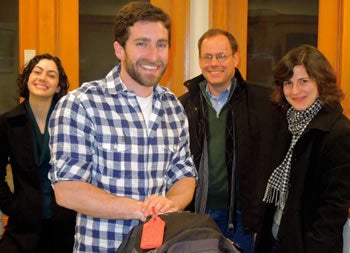In a Supreme Court case, the International Human Rights Clinic argues that the Alien Tort Statute applies to corporations
It started off with an insult: A French adventurer, standing in the streets of Philadelphia, called the ambassador of France a nasty name. And perhaps if it had ended there, the Alien Tort Statute might never have come to be.
But language was not enough for the Chevalier de Longchamps, who was nursing a grudge. He lunged toward the ambassador. He hit the ambassador’s cane with his own. And in assaulting a foreign ambassador, Longchamps committed a violation of the law of nations.
It was 1784. The incident in Philadelphia drew international attention; then condemnation; then ridicule, as the Continental Congress lacked the power to take meaningful action in response.
Five years later, as part of the First Judiciary Act, the founders sent a strong message with what they called the Alien Tort Statute: “The district courts shall have original jurisdiction of any civil action by an alien for a tort only, committed in violation of the law of nations or a treaty of the United States.”
It was an important gesture to the international community—a symbol of solidarity, historians would say: We will open up our new federal court system to victims of violations of the law of nations.
The United States had arrived.
PART I
On the morning of Feb. 28, 2012, a team from Harvard Law School’s International Human Rights Clinic took their seats in the U.S. Supreme Court. Sitting directly behind petitioners’ counsel were Clinical Professor Tyler Giannini and Assistant Clinical Professor Susan Farbstein ’04, nationally recognized leaders in Alien Tort Statute litigation, and co-directors of the clinic.
They had waited months to hear oral arguments in Kiobel v. Royal Dutch Petroleum Co., a case that would test the limits of the centuries-old ATS. It was the highest-profile human rights case to come before the Supreme Court in years.
Even before the Court granted certiorari, Kiobel had become an international flash point for the debate on corporate accountability, generating nearly 40 amicus briefs analyzing the ATS from every angle—foreign policy, the global economy, the international human rights movement. HLS staff, students and alumni were involved on both sides of the issue. For its part, the clinic filed a brief on behalf of legal historians, in support of petitioners.
“What’s at stake in Kiobel is the future of the ATS itself, and whether it will remain an example of how the United States takes its international legal obligations seriously,” said Farbstein.
Kiobel began like any other ATS case in recent memory—with allegations against a company or an individual for violations of international law. Esther Kiobel and 11 other members of the Ogoni people in Nigeria filed suit against Shell in 2002, alleging crimes against humanity, including complicity in torture and extrajudicial executions. At issue: the company’s actions from 1992 to 1995, when the Ogoni were protesting oil development activities on their land.
Because Shell does much of its business in the United States, the courts agreed to hear the case. But on appeal, the 2nd Circuit turned its attention away from the case and toward the statute itself, dismissing Kiobel on the grounds that corporations could not be held liable under the ATS.
For observers of the ATS, this came as a surprise: For years, courts had allowed cases to proceed on the presumption that corporations were as liable as individuals for violations of international law.
“No one had really questioned it,” said Jenny Martinez ’97, a professor at Stanford Law School and one of the amici represented by the clinic. “It did seem rather obvious.”
After the 2nd Circuit’s ruling, other appellate courts went in the opposite direction, finding corporate liability permissible under the ATS—in cases against Exxon Mobil Corp. for violence in Indonesia, the Rio Tinto mining group for violence in Papua New Guinea, and Firestone tire company for child labor in West Africa.
“It was clear from the split in the lower courts that the question in Kiobel—whether a corporation could be held liable—was a central and fundamental threshold question that had to be clarified,” said Giannini.
Sooner or later, he said, the issue was headed to the Supreme Court.
PART II
By any standard, the Alien Tort Statute leaves room for interpretation. It offers guidance on the nature of the violation, the remedy and the victim—but not one word on the nature of the defendant.
In its brief, the clinic argued that the framers were well-acquainted with the corporate form and would never have intended to provide a corporate carve-out under the ATS. They based that argument on a year and a half of research, reviewing 500 years of case law and piecing together the history surrounding the Alien Tort Statute.
“How do you interpret a statute that was passed in 1789? You look at the way it would have been read in 1789, and then you translate the principles to today.”
Russell Kornblith ’12
“How do you interpret a statute that was passed in 1789?” said Russell Kornblith ’12, a clinical team member. “You look at the way it would have been read in 1789, and then you translate the principles to today.”
At the time, corporations were rare in England and nonexistent in America, where the founders had a lingering distaste for the British East India Company. Still, the notion of corporate accountability was already taking shape, with England keeping its corporations in close check through royally granted business charters.
“This is not some shocking innovation,” said William Casto, a professor at Texas Tech University School of Law and one of the amici represented by the clinic. “Two hundred years ago, they had similar problems, and they came up with the same solutions.”
Take, for example, Skinner v. East India Trading Company. The case is primarily known today for the jurisdictional dispute it caused between the House of Lords and the House of Commons. But in reviewing it again, the clinic found something equally compelling: At its heart, it was the case of a man facing down a monopoly.
In 1657, Thomas Skinner headed out onto the high seas near East Asia, hoping to make his fortune as a merchant. When crews from the East India Company ransacked his ship and seized his land, he sought compensation from the company, to no avail. Finally, he turned to the House of Lords.
The East India Company argued it could not be held liable for the actions of its agents, but the House of Lords rejected that argument and awarded Skinner 5,000 pounds.
PART III
After the Kiobel oral arguments, the clinical team enjoyed a week of quiet. Then came another twist. In a rare move, the justices requested supplemental briefing on a different question about the statute: Does the ATS apply to acts committed on foreign territory?
Courts have traditionally interpreted the ATS as a broad remedy for victims of violations of international law, no matter where the acts occur.
Still, some have argued that because the framers did not specify otherwise, they intended the ATS to provide a civil remedy for only a limited set of international violations either committed by Americans, or on American soil or the high seas.

In early spring, the clinic began its own research to prepare a second brief on behalf of legal historians, including HLS Professor Charles Donahue. In examining the historical record, it seemed clear to the team that the framers would have understood the word “tort” in terms of the transitory tort doctrine of the day: A tort violation traveled with the violator.
A raid in British-owned Sierra Leone stood out. In a famous 1795 opinion, U.S. Attorney General William Bradford stated he had “no doubt” the ATS could apply as a remedy for British victims of the raid.
But did the raid take place on the high seas, in which case maritime law might apply, or did it take place on the sovereign territory of another country? It was a question that had been debated for years in scholarly circles.
During the earlier round of briefing, the clinic had gone in search of an answer, emailing a group of alumni and students at the School of Oriental and African Studies in London with a request: See if you can find eyewitness accounts of the raid that Bradford references in his opinion.
The clinic had been working all year long with this group, relying on them to find original documents in England’s archives. It took a few days, but then, deep in the Foreign Office records of the British National Archives, the London team found what the clinic was looking for: a full accounting of the raid.
The discovery was critical for the briefing on extraterritoriality. The correspondence described attacks on land, including the looting of a British library—proof that Bradford knew the raid had taken place in British sovereign territory when he suggested the ATS would apply.
PART IV
Today, the words “Alien Tort Statute” are synonymous with human rights impact litigation. But for centuries, as the law of nations evolved, the statute lay dormant.
During the founders’ era, the modern conception of human rights had yet to emerge. The law of nations protected victims of piracy; people whose safe passage came under threat; and foreign ambassadors, who were considered protectors of peace. But principally, the law of nations governed the behavior of states, not individuals.
Filártiga, then a New York resident, had received a tip that the man who killed her brother Joelito was living in New York. Paraguayan courts had dismissed the case against him; the plaintiff’s lawyer had been threatened with death. She turned to U.S. courts for a remedy, bringing claims under the ATS against the police chief for torture, a violation of customary international law. And in 1980, the 2nd Circuit—the same court that would later dismiss Kiobel—allowed her case to proceed.
“For purposes of civil liability, the torturer has become—like the pirate and slave trader before him—‘hostis humani generis,’ an enemy of all mankind,” wrote the court.
And so the ATS was reanimated in a different era, under a different body of international law.
That is the history. With the Supreme Court’s ruling expected sometime this term, the clinic is now concerned about the future. Ask the team what’s at stake, and they will tell you: our ability to protect human rights and our international standing.
For the clinical team, there is also this major consideration: their clients. Dozens of ATS cases are on hold, pending the Court’s decision. The clinic has supported plaintiffs in many of them, in charges against former leaders in Bolivia living in the United States; against former Somali officials accused of abusing political opponents; and against multinational companies that built tanks and designed identification cards for the South African government during apartheid.
Poppy Alexander ’12 has one man’s face in mind—a man she met in South Africa while interviewing survivors of apartheid for one of the clinic’s corporate ATS cases.
“I can’t even think about him because it’s too upsetting,” she says.
All the talk about ships and pirates and corporations and the law of nations—at the end of it all, Alexander is just hoping the Supreme Court’s ruling won’t leave that man behind.
